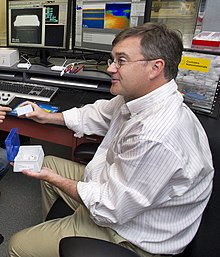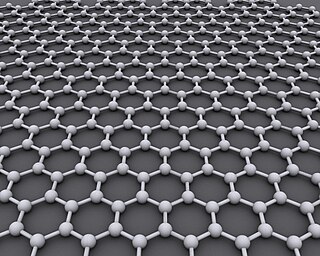
Graphene is an allotrope of carbon consisting of a single layer of atoms arranged in a hexagonal lattice nanostructure. The name is derived from "graphite" and the suffix -ene, reflecting the fact that the graphite allotrope of carbon contains numerous double bonds.

In materials science, a single crystal is a material in which the crystal lattice of the entire sample is continuous and unbroken to the edges of the sample, with no grain boundaries. The absence of the defects associated with grain boundaries can give monocrystals unique properties, particularly mechanical, optical and electrical, which can also be anisotropic, depending on the type of crystallographic structure. These properties, in addition to making some gems precious, are industrially used in technological applications, especially in optics and electronics.
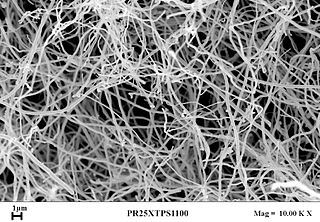
Carbon nanofibers (CNFs), vapor grown carbon fibers (VGCFs), or vapor grown carbon nanofibers (VGCNFs) are cylindrical nanostructures with graphene layers arranged as stacked cones, cups or plates. Carbon nanofibers with graphene layers wrapped into perfect cylinders are called carbon nanotubes.
As the world's energy demand continues to grow, the development of more efficient and sustainable technologies for generating and storing energy is becoming increasingly important. According to Dr. Wade Adams from Rice University, energy will be the most pressing problem facing humanity in the next 50 years and nanotechnology has potential to solve this issue. Nanotechnology, a relatively new field of science and engineering, has shown promise to have a significant impact on the energy industry. Nanotechnology is defined as any technology that contains particles with one dimension under 100 nanometers in length. For scale, a single virus particle is about 100 nanometers wide.
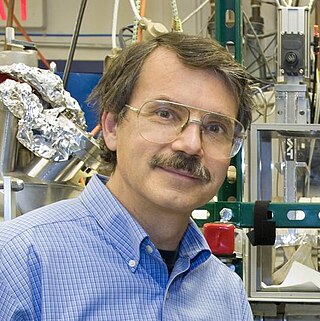
Alex K. Zettl is an American experimental physicist, educator, and inventor.
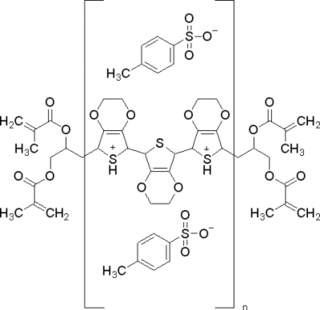
Poly(3,4-ethylenedioxythiophene)-tetramethacrylate or PEDOT-TMA is a p-type conducting polymer based on 3,4-ethylenedioxylthiophene or the EDOT monomer. It is a modification of the PEDOT structure. Advantages of this polymer relative to PEDOT are that it is dispersible in organic solvents, and it is non-corrosive. PEDOT-TMA was developed under a contract with the National Science Foundation, and it was first announced publicly on April 12, 2004. The trade name for PEDOT-TMA is Oligotron. PEDOT-TMA was featured in an article entitled "Next Stretch for Plastic Electronics" that appeared in Scientific American in 2004. The U.S. Patent office issued a patent protecting PEDOT-TMA on April 22, 2008.
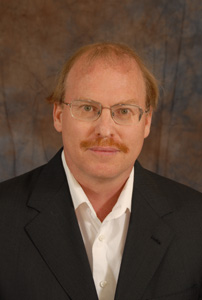
Rodney S. "Rod" Ruoff is an American physical chemist and nanoscience researcher. He is one of the world experts on carbon materials including carbon nanostructures such as fullerenes, nanotubes, graphene, diamond, and has had pioneering discoveries on such materials and others. Ruoff received his B.S. in Chemistry from the University of Texas at Austin (1981) and his Ph.D. in Chemical Physics at the University of Illinois-Urbana (1988). After a Fulbright Fellowship at the MPI fuer Stroemungsforschung in Goettingen, Germany (1989) and postdoctoral work at the IBM T. J. Watson Research Center (1990–91), Ruoff became a staff scientist in the Molecular Physics Laboratory at SRI International (1991–1996). He is currently UNIST Distinguished Professor at the Ulsan National Institute of Science and Technology (UNIST), and the director of the Center for Multidimensional Carbon Materials, an Institute for Basic Science Center located at UNIST.
Bilayer graphene is a material consisting of two layers of graphene. One of the first reports of bilayer graphene was in the seminal 2004 Science paper by Geim and colleagues, in which they described devices "which contained just one, two, or three atomic layers"
In situ electron microscopy is an investigatory technique where an electron microscope is used to watch a sample's response to a stimulus in real time. Due to the nature of the high-energy beam of electrons used to image a sample in an electron microscope, microscopists have long observed that specimens are routinely changed or damaged by the electron beam. Starting in the 1960s, and using transmission electron microscopes (TEMs), scientists made deliberate attempts to modify materials while the sample was in the specimen chamber, and to capture images through time of the induced damages.

Lee Young-hee is a South Korean physicist. He is currently professor in physics and energy science at Sungkyunkwan University as a SKKU fellow. He is also director of the Center for Integrated Nanostructure Physics in the Institute for Basic Science (IBS). He has been a Clarivate Analytics Highly Cited Researcher in the cross-field category in 2018, 2019, and 2020.
Alan T. Charlie Johnson is an American physicist, professor of Physics and Astronomy at the University of Pennsylvania, and the Director of the Nano/Bio Interface Center at the University of Pennsylvania.
Xu Jianbin is a professor in the department of electronic engineering and director of material research center at The Chinese University of Hong Kong (CUHK). He is also a Distinguished Research Fellow at the Shenzhen Institutes of Advanced Technology, one of the Chinese Academy of Sciences.
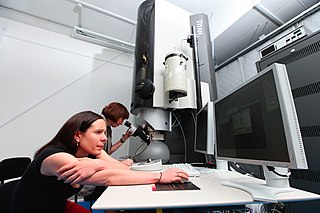
Sarah Jane Haigh is a Professor in the School of Materials at the University of Manchester. She investigates nanomaterials using transmission electron microscopy, including two-dimensional materials such as graphene.
Pinshane Yeh Huang is an Associate Professor of Materials Science at the University of Illinois at Urbana–Champaign. She develops transmission electron microscopy to investigate two-dimensional materials. During her PhD she discovered the thinnest piece of glass in the world, which was included in the Guinness World Records. Huang was awarded the 2019 Presidential Early Career Award for Scientists and Engineers.
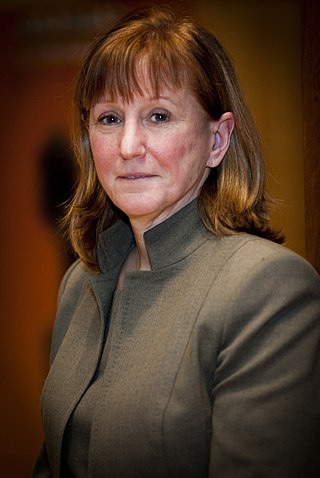
Dawn Austin Bonnell is the Senior Vice Provost for Research at the University of Pennsylvania. She has previously served as the Founding Director of the National Science Foundation Nano–Bio Interface Center, Vice President of the American Ceramic Society and President of the American Vacuum Society.
David Muller is a named Professor in the School of Applied and Engineering Physics at Cornell University and co-director of the Kavli Institute at Cornell for Nanoscale Science. He is known for his work in electron microscopy, condensed matter physics, and discovery of atomic structure across a wide range of materials including applications in clean energy research, semiconductor devices, and 2D materials. He is a fellow in the American Physical Society and the Microscopy Society of America and received the MSA Burton Medal, the MAS Duncumb Award, and the Ernst Ruska Prize of the German Society for Electron Microscopy. He is twice in the Guinness World Records, most recently, for achieving the highest resolution microscope image ever recorded using electron ptychography. His work spans theory, computation, and experimental physics research. He is also a Faculty member of the Center for Bright Beams.
Xiaodong Zou is a Chinese-Swedish chemist who is a professor at Stockholm University. Her research considers the development of electron diffraction for the three dimensional characterisation of materials. She is a member of the Nobel Committee for Chemistry. She was elected to the Royal Swedish Academy of Sciences and the Royal Swedish Academy of Engineering Sciences.

Park Jeong Young, sometimes written as Park, Jeong Y., is a professor in the Department of Chemistry at KAIST and associate director at the Center for Nanomaterials and Chemical Reactions at the Institute for Basic Science. He is a member of the American Chemical Society and American Vacuum Society among others, an international committee member of Asian Science Camp, and has served on the editorial boards of Scientific Reports, Advanced Materials Interfaces, Journal of the Korean Physical Society, and New Physics.
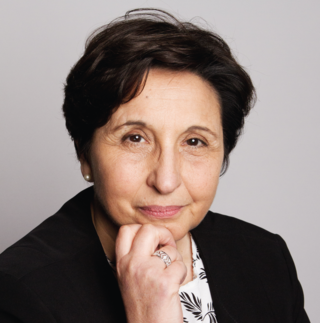
Maria C. Asensio is a Spanish-Argentinian physical chemist, academic, researcher, and author. She is a Full Research Professor at the Materials Science Institute of Madrid (ICMM) of the Spanish National Research Council (CSIC) and Chair of the CSIC Research Associated Unit-MATINÉE created between the ICMM and the Institute of Materials Science (ICMUV) of the Valencia University.
Angus Ian KirklandFInstP FRSC FRMS is the JEOL Professor of Electron Microscopy at the Department of Materials, University of Oxford. Professor Kirkland specialises in High-resolution transmission electron microscopy and Scanning transmission electron microscopy.
